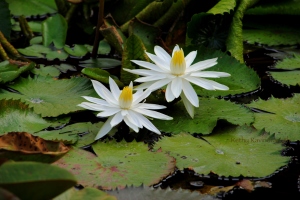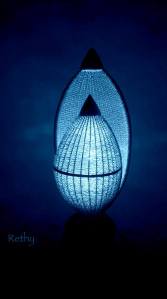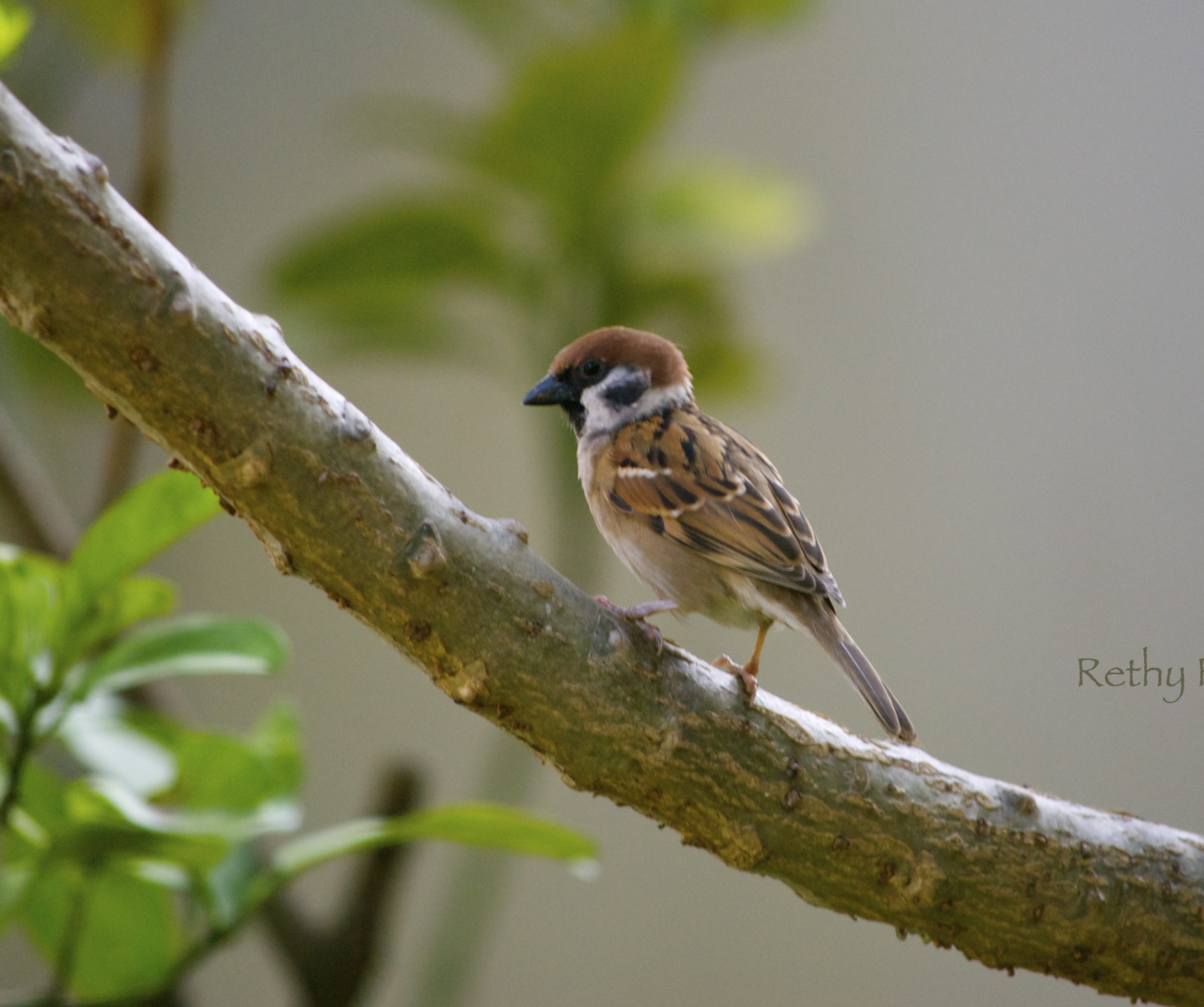Lotus that rises pure and fragrant above the muddy waters has always been a symbol of purity and spirituality. In Buddhism, Hinduism, Jainism and Sikhism the flower is highly regarded and has a very prominent position. In Buddhist art and literature lotus motifs are highly symbolic. . A fully bloomed flower symbolises enlightenment where as the one in bud form shows a period before enlightenment. Mandalas and chakras are linked with lotus symbol. Lotus or padma is an integral part while depicting Hindu gods and goddesses. Probably my association with the Cambodian and Vietnamese cultures drew me closer to the significance of this flower as a symbol and also in the everyday lives of people. Thus the passion and love for the flower was rekindled.
In Hindu mythology Sun and Lotus are connected. Lotus is Sun’s beloved; Lotus has no existence without the Sun. During the churning of the ocean goddess Lakshmi comes out standing on the lotus. Similarly in Egyptian mythology sun god Ra, the creator, emerged from the primeval waters sitting on a lotus. Like the Sun who disappears at night and comes back to life in the morning, the flower re-emerges from water everyday. Per contra, most of the water lilies bloom at night hence called the beloved of the Moon.
In Egyptian culture the blue lotus has a significant role and is associated with rebirth. Blue Lotus definitely adds a dreamy aura and regality to the flower; a magical and mystical air to the stately flower. The blue lotus that appears in Egyptian culture and Greek mythology could be the blue water lily; Nymphaea caerulea (Egyptian lotus, blue water lily, sacred water lily) or Nymphaea nouchali (Blue star water lily which is the National flower of Sri Lanka) and not Lotus flower, Nelumbo nucifera ( Indian lotus, national flower of India and Vietnam). Hence I came to the conclusion that Blue Lotus is scientifically water lily and symbolically blue coloured lotus. Blue water lilies and white lotus were native to Egypt and were both offerings at tombs and temples. Pink lotus of India was introduced to Egypt much later.
Nymphaea caerulea


Nymphaea pubescens
 Nelumbo nucifera
Nelumbo nucifera
White lotus
Apart from the spiritual aspect, lotus and water lilies play a major role in the everyday life of the layman. Both are widely used in South Asian kitchens. In Khmer and Vietnamese cuisine water lilies are used in soups and salads. Lotus tea and Blue lotus tea are widely available in Vietnam. Both the flowers are renowned for medicinal properties too.

Blue lotus tea

A painting inspired by the mystical and mysterious Blue Lotus of my village
Scholars say that the blue lotus is widely depicted on the walls, pillars, thrones, papyrus scrolls and head dresses of the pharaohs of ancient Egypt. The bloom was known as the Sacred Lily of the Nile. I read an interesting article by Kirsten Cowart where the restorative powers of this sacred flower is mentioned. Goddess Isis also has seen bearing lotus. Among her many titles like Diadem of Life, Creatrix of The Nile, Divine Mother, Giver of Life and so on Lotus-bearing is one title. (Isis Bearing The Blue Lotus~Linda Iles)

Egyptian murals and carvings portraying men and women indulging in revels, holding bunches of blue lotuses and smelling them could be a hint on the intoxicating properties of the flower. The god of Healing power and Perfume, Nefertem holds bunches of blue lotus and he offers this to Ra, the sun god to sooth his pain.
It seems the flower has properties to calm the nerves and brain. Homer in his Odyssey mentions about Odysseus’ men who fall into a blissful forgetfulness after munching the lotus flower and fruits. He had to drag his men back to the ship and tie them to the rowing benches to resume their voyage back home. I wonder whether it is the blue lotus that has enchanted and ensnared the Greek heroes.
In Tennyson’s ‘The Lotus Eaters’ he weaves the story around the same isle where Ulysses ( Odysseus) and his mariners had spent time. The enchanted flower that the Lotus eaters of the island offered them had the power to change their minds. The mariners wanted to linger on that dreamy island forever. They come to the conclusion that ‘slumber is more sweet than toil.
My Blue Lotus has an entirely different shade of blue. The blue lotus I have heard and wondered about right form my early childhood is one of its kind, a faith or a fascinating myth associated with a temple in our village.

The serene temple premises

The story that intrigued us as children is about a sacred bloom called neelathamara (നീലത്താമര) . Those who keep a coin on the steps of the sanctum sanctorum of a nearby temple, with a wish in their heart, would be blessed to see a bloom in the temple pond the next morning. This would be a sign that the wish is going to be fulfilled. The unique flower is known as Neelathamara the malayalam equivalent of Blue Lotus. Neela thamara sounds more royal and desirable than chengazhineer poovu the original, though mediocre, name for the bloom.
The practice still continues but with changing times not many venture this divine intervention for personal favours. The flower is exclusively used for certain special auspicious rituals and sacred rites (കലശം,പ്രതിഷ്ഠ) in other temples, such as idol installation or for the glorification of the deity. The divine flower blooms in the morning in one of the deep rock pits on either side of the pond, provided the money is kept on the temple steps the previous evening.

stones that stood the test of time
My visit to the temple was after a long interval of more than ten years. Previous visit was with my father and for no reason I have never been there after he left us to the heavenly abode. The day we went, we were told that neelathamara was abloom that day as a temple in a distant district needed the flower for an auspicious occasion, but we missed the chance to see the sacred flower.

The temple pond

The kokkarni or the deep rock pit at the side of the pond
The 300 year temple in our little hamlet was always referred as Manokkavu, a shortened and colloquial version of Malamalkavu (മലമൽക്കാവ്). The temple sits on a hillock hence the name, the temple atop the hill… When my daughter mentioned, I was astonished to know that there is a similar sounding place called Manukau in Auckland!

When there’s too much rains that threaten a function to be held in a household or when there’s a need for rains for the crops to grow, people in my village offer a ‘koottupayasam‘ (കൂട്ടുപായസം) or a sweet rice dish to the temple deity and their woes are taken care of. A koottupayasam or ‘ada’ (അട) was a usual offering that my grandmother used to do then. The devotees are never disappointed as Lord Ayyappa always heard their prayers.

The story of the Neelathamara has remained mysterious and fascinated our minds. Am still curious about the appearance of the flower. Interestingly, the blue lotus has nothing blue about it like the blue moon! This same Blue lotus has been the theme of a famous Malayalam film, based on the story of the veteran writer M.T Vasudevan Nair from our nearby village. In the early part of this century the film was remade to become a huge hit once again. Even though Malamalkkavu is already well reputed as one of the two major schools of Thayambaka, the Percussion music in Kerala, the temple that is nestled in an unknown corner of Palakkad district earned more fame through M.T’s story, Lal Jose’s and Late Yousafali Kecheri’s films based on the story.

Yours truly and her mother in front of the age-old ootupura

Certain beliefs have no scientific explanations and Neelathamara remains an enigma. The simple and good-hearted souls of this small village has deep faith and great pride in their powerful deity and this miraculous flower.


Really a large story.. all behind neelathamara.
LikeLike
The mysterious, Neelathamara flower,
LikeLike
Thank you very much. Best wishes!
LikeLiked by 1 person
This is all so interesting. You’d giggle, I’m sure, to hear how I pronounce many of these words to myself while I’m reading!
I started thinking about symbolic flowers in other traditions, and realized that the lily and the rose figure prominently in Christianity. I’m not sure whether Muslim traditions have certain flowers that hold meaning or not. I suspect not,since I know that flowers generally aren’t offered as funeral gifts and so on.
The lotus is a beautiful flower, but so is the photo of you and your mother beautiful. I’m so glad you shared it!
LikeLiked by 1 person
Thank you very much Linda for your kindness 🙂 Interesting observation on flowers.There’s a sonnet on the birth of the flower ‘LOTUS’ by a 19th century Indian poet Toru Dutt. She used to write in English and French and died in her early 20s. Toru Dutt’s poem is about how Flora gave Lotus to the god of Love when there was a dispute between Lily and Rose in Psyche’s bower.
If you have time and patience have a look at an old blog on lotus and I have quoted the poem there.
https://rethyravi.wordpress.com/2014/09/25/the-land-of-lotus-blooms/
Thanks and happy blogging!
LikeLike
I just came across this interesting article, and thought you might find it interesting, too.
LikeLiked by 1 person
Thank you Linda! The place looks so tranquil.
LikeLike